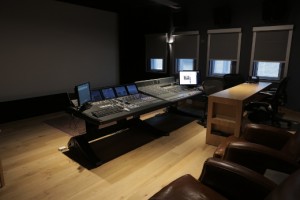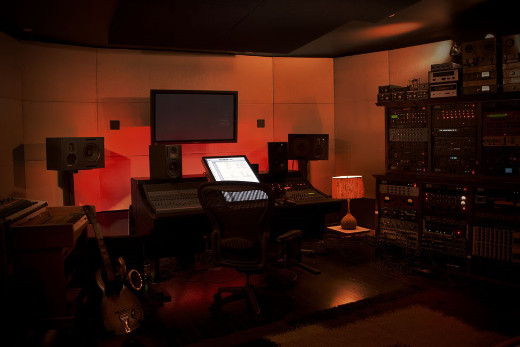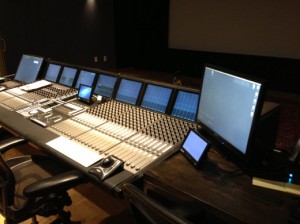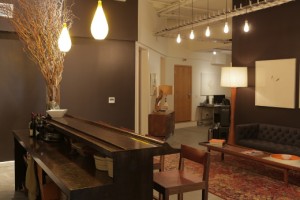NYC Audio Post Re-Energized: Harbor Sound Arrives
Something is taking shape in TriBeCa.
The vaunted film festival that carries the neighborhood’s name is going strong as always, but long after the screenings and schmoozing are over, notable film activity is going to keep right on rolling downtown – in an imaginative new form.
Harbor Sound has arrived, providing NYC with a 10,000 sq. ft. facility for Dolby-certified audio post in feature-film sized soundstages, and the high-level original music offerings of composer Mitch Davis’ Pull right alongside. Joined together with Harbor Pictures, an accomplished creator of film/commercial/TV/Web content, the entity forms a strong new presence – one striving to advance the “all-under-one-roof” philosophy as it elevates the fortunes of NY production and post.
A Fresh Model to Fill the Sound One Void
The sudden, but not surprising, demise of NYC film and TV mixing powerhouse Sound One unfolded in dramatic fashion last October: In one swipe of an accountant’s pen, five re-recording studios, two ADR studios, a Foley studio, and nearly 100 editing suites went dark – and nearly 40 industry veterans were suddenly unemployed. Afterwards, many wondered if the city would be able to retain the talent who performed Academy Award-winning audio post there for the likes of Woody Allen, Ang Lee, Martin Scorcese, and Spike Lee, over the course of an admirable 40+ years run in midtown’s famed Brill Building.
In order for those top mixers and sound editors to keep the business in NYC, they would need more than just the Empire State Film Post Production Tax Credit to help out – they would also have to find a new facility to work in. Operating just below Houston, at the corner of Varick and King, the newly minted Harbor Sound has emerged as just such a resource, serving as a completely updated home base for former Sound One full-time and resident talent including Supervising Re-Recording Mixer Robert Fernandez, and Supervising Sound Editors Dave Paterson, Bob Hein, Damian Volpe, Glen Payne, and Warren Shaw – with more big names on the way. Visiting feature film mixers have already included Mike Minkler and Lee Dichter.
What attracted them to these spacious, open, and airy new rooms, built out over the last few months within Pull’s large and exceedingly comfortable confines? Probably a sense of the unique partnership formed by Pull and Harbor Pictures, one that seeks to introduce a spirited paradigm into the content creation world.
“Harbor is an artist-owned creative studio for feature film, TV and commercials,” explains Zak Tucker, President of Harbor Pictures. “This is a full-service studio providing boutique-level artistry with a commercial infrastructure – services we offer here include offline editorial, color FX, and sound finishing, all in collaboration with Pull’s music composition.
“You have top flight artists of all disciplines,” Tucker continues, “coming together under one roof to enable the creative and production workflow from start to finish. This place is about putting artistry first, while at the same time doing it out of respect for high level technology integration and support.”
A Critical Time for NY Audio Post

Studio B provides Dolby-certified sound and natural light — an uncommon combination. (click to enlarge)
Harbor Sound is arriving at an opportune time. The Empire State Film Post Production Tax Credit, which was originally signed into law by New York Governor Andrew M. Cuomo in July of 2012, got an additional boost last month with an expansion and five-year extension. Recently approved were an $18 million increase in the annual funds allocated specifically to the post production incentive, a five-year extension of the incentive program to the year 2019, plus more attractive qualifying standards for film projects being shot and/or completed in New York.
The Post Production Credit itself now stands at a fully-refundable 30% (35% for upstate NY) tax credit on post production costs, as long as a project spends 75% of the post production costs in New York. Combined with a separate program, the New York State Film Production Credit which began in 2004, what it adds up to is a healthy era for film, TV and high-level Web production to be working somewhere in New York state.
Content creators are taking notice: during the Cuomo administration alone, it’s estimated that the 338 projects that have filmed or applied to the film and television tax credit program during the Cuomo administration will result in over $5.2 billion in direct spending in New York. Recent productions that have come onboard in NY include “America’s Got Talent” (relocating to Radio City Music Hall), “The Tonight Show”, and The Amazing Spider-Man 2 (estimated to result in 3,500 jobs, not to mention the casting of 11,000 extras statewide).
In NYC, there are multiple facilities such as c5 Sound, Soundtrack F/T, Digit It Audio, Sound Lounge, DuArt, Fall on Your Sword, and audioEngine, to name just a few, with the experience and talent to take part in the action. But the closure of Sound One left Manhattan without a flagship, something the city’s audio post scene requires for psychological reasons, as much as economic ones.
“Most notably on the film and TV audio post landscape, the mainstay long-standing facility closed months ago and it created a vacuum,” Tucker observes. “There was a real concern for us on the picture side that, without a legitimate offering for audio post in NY, productions would go back to L.A. and not even do picture in NYC – once sound gets pulled, production companies start pulling everything.
“This endeavor seemed like both an opportunity and a necessity, to marshal the financial and creative resources to make a legitimate audio post offering in NYC. We wanted to ensure that studio productions felt there was sufficient infrastructure here, so they will continue to think of NYC as a place to get their work done.”
A Service Convergence
While the triumvirate of Harbor Pictures, Harbor Sound, and Pull should have a halo effect on the region as a whole, naturally the hope among the partners is that their collaboration will be good for their respective businesses. With high-level film/video production, original music scoring, and audio post entities literally under one roof, constantly interacting and referring each other, opportunities can be expected to open up for each other time and again.
The seeds of this ambitious collaboration were sown when Harbor Pictures, helmed by Tucker and co-founder Theo Stanley, moved their fast-expanding company to the 4th floor at 185 Varick Street in 2010. Harbor’s A-list clientele includes ABC, NBC, HBO, Weinstein Company, Fox Searchlight, Adidas, Bloomingdales, Tommy Hilfiger, Grey NY, Ogilvy, and dozens more.
The creative commons at Harbor Pictures soon caught the eye of Mitch Davis and Scott Brittingham, co-founders of the successful full-service music company Pull that had been operating on the building’s first floor since 2001. Pull was originally established as a private recording studio to facilitate Davis’ prolific output, serving as fertile ground for his personal album work as Orba Squara, along with original music for film, TV and commercials. Between synch licensing and original music, Davis’ music-to-picture portfolio forms its own A-list that includes Apple, Firestone, Captain Morgan, Optimum, Nike, VH1/MTV, Lexus, The New York Times, Walmart, and Sun Chips, among others.
The uncommonly comfortable vibe at Pull – its atmosphere evolved organically into a magical mix of a sprawling loft apartment, recording facility, and retro-geek/chic playground – became an attractive force for the studio. Word began to spread about Pull in the underground, bringing in select artists to write and record there that include U2, Mark Lanegan, Danger Mouse, Billy Squier, Tracii Guns, Stephen Malkmus, Bebel Gilberto, plus Bobby Womack and Damon Albarn.
“Pull was always about doing things that were fun and interesting for us,” Davis says. “That’s why we kept it low overhead, with a small staff, and we pick and choose what we do. We’ve been fortunate enough to work with a lot of great people, but we also realized we had been to the top level as a studio. Scott and I said to each other, ‘Where do we go from here?’”
As a friendship between Harbor Pictures and Pull developed, so did work opportunities, with Tucker starting to call on Davis when video/film clients were in sudden need of underscore or a track to license. With 5,000 sq. ft. of space just being used by Davis, Brittingham, and their occasional guests – and 5,000 sq. ft. more available if needed – a light bulb came on: expand Pull’s infrastructure to include audio post, and create a high-functioning production/post 360 where everyone would benefit.
21st Century Design
Coincidentally, this thought process was unfolding just as Sound One began to implode 50 blocks uptown. “As Sound One was closing, we reached out to some of the top artists there and asked them if they were looking for a home,” Tucker explains. “We spent quite a lot of time talking to them, and they saw this was the place for the next iteration of their careers.”
Before they got the mixers and sound editors onboard, however, Harbor Sound scored a key recruit in Avi Laniado, who rose to Chief Engineer at Sound One during an amazing 28-year run there. The Harbor/Pull partnership looked to Laniado to spec and connect the new rooms – as non-traditionally as possible. “The first thing Zak told me,” says Laniado, Chief Engineer for Harbor Sound, “was ‘think outside of the box.’ Details like the screen size, projector placement, and viewing angles were considered right from the start, instead of being left for last.
“We got rid of the audio post model that was already in place,” Laniado continues. “Instead, we built these soundstages with the end result in mind at all times, and when you put it together it makes a huge difference: The simplicity of the rooms is very inviting.”
To create the soundstages within Pull, the studio’s sizable lounge and its large live space were converted to the new purpose. A combination ADR studio and live room is currently under construction. Meanwhile, Davis’ 22’ x 24’ personal production studio, which houses a large collection of vintage synths, analog gear, and eclectic instruments, was left intact along with Pull’s relaxed and inspiring vibe.
Both of Harbor Sound’s Dolby-certified soundstages, the 33’ x 25’ x 13’ Studio A and the 25’ x 22’ x 13’ Studio B, are equipped with JBL 4722 Cinema Loudspeakers (LCR) and 8340A Cinema Surround monitors (surround) – all fitted with BMS coaxial neodymium compression drivers, along with Meyer Sound x-800C Cinema Subwoofers. They sport a clean and minimal look, and Studio B is blessed with natural light — the effect is one of a drastically updated aesthetic, one that stands in marked contrast to the darkly enclosed environments that currently predominate NYC audio post.
Meanwhile, the controller selected for both rooms is the Euphonix System 5, a choice that Harbor Sound arrived at after surveying a number of top mixers and supervising sound editors. “The Euphonix System 5 is the best of both worlds,” Laniado notes. “It has the DSP processing built into the console, which appeals to certain mixers. Yet if they want to work in virtual mode with Pro Tools, they can do that as well. In the process of pre-mixing, which can be very slow and detailed, you want to remain virtual, so you can build everything as much possible inside the box.
“But there are certain styles and stages of post mixing when speed is of the essence, and that’s more efficient when you use the on-board DSP. When you get to the final stage, you want to move as fast as possible for the client — you want to commit to things, mixing down to tracks and stems, as you create the end product.”
According to Laniado, the key to managing Harbor Sound’s technical plant is maintaining a flexible mindset at all times. “The technology is changing at a faster and faster rate,” he observes. “The most challenging aspect is thinking far enough ahead to address all the possibilities that you’ll end up facing. In the past, things were almost status quo: You built something with the design concept of it being around for 15 years and not changing. Now every decision you make could change two years down the road. You want the facility’s infrastructure to be efficient and streamlined – whatever choice you make must be done with an open mind.”
Healthy Competition
Artist-owned creative collectives are not a new concept, and all-under-one-roof gatherings of interconnected offerings can be found everywhere, in just about every service industry you can name.
Still, it’s not a stretch to say that Harbor’s entry represents an evolved paradigm in production and post for the New York region.
Their opening represents both a disruptor and a beacon in the high end of the NYC audio post scene: Harbor Sound brings serious new competition to all of the existing facilities in the area – but its presence may also very well reinvigorate this vital sector that flagged emotionally in the wake of Sound One’s closing, ultimately drawing in more mixing, editing, and ADR work for everyone.
The positive energy at Harbor Sound right now is palpable, with word already spreading and a number of mixing and original music projects booked there after just a few weeks in operation. But despite the fast start, its partners know that much about their new venture remains to be seen.
“This whole place is literally an idea, an experiment,” Zak Tucker says. “Can artists, producers, and technologists come together and create something of their own making that’s not backed by a giant conglomerate? That’s the risk – that this is just a vision. But it’s rare to have this level of technology, engineering expertise and artistry, for picture and sound, in the same place. We’re bringing talented people together, and we’re fortunate that everyone has somehow managed to dovetail their own interests with the growth of this idea.”
Moving forward with the right mix of caution and optimism, the convergence of Harbor Pictures, Harbor Sound and Pull just may prove to be Something Big. “I think this facility could be a nexus for creative film and sound in NYC,” says Tucker. “We’re trying to lower the barriers that get in the way of creativity, whether those are financial, workflow, or geographical. Things that weren’t possible, will be possible.”
– David Weiss
Please note: When you buy products through links on this page, we may earn an affiliate commission.











marc
October 8, 2013 at 6:37 pm (11 years ago)This is the worst post production sound house in New York, filled with corrupt employees who do not understand the technology, I produced an indie feature had Harbor Sound and they wasted my money and time. Do not work with these crooks, go to Goldcreast. http://www.goldcrestfilms.com